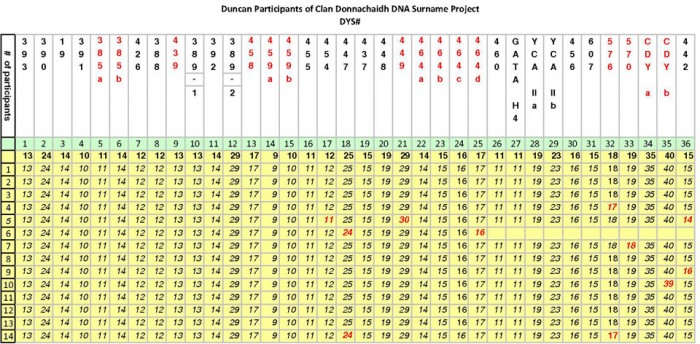
Clan Donnachaidh DNA Project
Robertson, Duncan, Reid, Donachie, McConnochie
Photo of –
The Five Sisters

Photo of –
The Five Sisters

Farewell to the Highlands, farewell to the North,
The birth-place of Valour, the country of Worth;
Wherever I wander, wherever I rove,
The hills of the Highlands for ever I love.
My heart’s in the Highlands, my heart is not here,
My heart’s in the Highlands, a-chasing the deer;
Chasing the wild-deer, and following the roe,
My heart’s in the Highlands, wherever I go.
My Heart’s in the Highlands, by: Robert Burns:
From the very beginning of the DNA research, the results clearly show that none of the main surnames of Clan Donnachaidh descended from a single progenitor. Therefore, the belief in some circles that all men of a given surname are biologically descended from that surname’s progenitor has not withstood the results produced by the DNA tests for Clan Donnachaidh. But the likelihood still exists that there are some surnames where most men today with a particular surname descend from the original progenitor of that surname. However, so far this scenario is not the case with the main surnames of this DNA project.
The Y-DNA test results clearly show that Clan Donnachaidh surnames tested so far had many different points of origin. The Duncans in America are a good example of this discovery. These Duncans started coalescing into well defined but separate groups in the early days of testing. Each of these Duncan groups is distinctly different from one another. What is the meaning of this finding? Each Duncan Group genetically has a different biological male founder within a genetic genealogy time period.
To further understand this point, we need to know that the current naming structure that we have today has not always been in use in our western cultures. Our current naming system developed over a period of time from the prior naming system. In the Gaelic speaking areas of Scotland, the single name of Donachie was a common Gaelic male name as in “Donnachie Reamhar” i.e., Stout Duncan. Over a period of time, the need arose to distinguish people more clearly. Therefore, the common male name Donachie assumed the place of a surname but in different geographic places and by different biologically unrelated men which again is what the Y-DNA test results are showing. The site “Scotlands People” has a good explanation of the history of naming structures in Scotland.
The Duncan lines in the United States have split into some well defined groups. These groups represent some of the male lines that populated America and descended from one or more progenitors. These founding Duncan men in America are but a sampling of the many separate and unrelated Duncan male lines that will be found in Scotland. Why? Not all male lines migrated out of Scotland to the new world. The same can be said for the surnames of Robertson and Reid in the other countries where our migrant forefathers settled.
Another point needs to be understood about DNA testing. The results show us that for the larger human population the old saying “We are All Related” is true. DNA studies have shown that we indeed are all related. The question then arise: Within what time frame is this relation? When and with what data, documents, and/or DNA, is the time period for this relationship.
Another important point about DNA testing should also be understood. Farther back in time before the development of surnames, these male lines will share a common ancestor. But unearthing that information is beyond the scope of genetic genealogy. The study of this ancestral genealogy is known as anthro-genealogy which looks at the migration of the human population through time and place on the earth. Much research is ongoing within this field of science which will someday give us an ideal picture of the origins of our migrating ancestors. When and how did our ancestors populate the land that we call today…..Scotland. When and where did my male and female ancestors arrive in Scotland?
This antro-genealogy field of population genetics will be covered more in-depth in another section. Visit this link The Peopling of Europe which gives some good reading and through on this subject pertaining to Europe.
Please understand that this is a collaborative research project.
We require the active participation of each member to further this genealogical and genetic study of our surnames and their place in history.
There is not one single DNA test to take but a series of DNA tests to continually dig deeper into our histories.
What do my test results look like?
When your Y-DNA test results are posted, you will be notified via email that they are ready for you to view. Remember that all of your test results and information are located on your personal page on the FTDNA website. Use your kit number and password to access your personal page.
The project’s raw Y-DNA data is listed at the FTDNA site FTDNA’s Donnachaidh DNA Project YDNA Results Page: We have sorted participants into associated and unassociated groups.
The Y-DNA test results are Short Tandem Repeat (STR) data. This data is presented as a set of numbers for the level of markers tested (chart 1). Short Tandem Repeat data is the pattern of repeating nucleotides you have for a particular marker. An example, for marker DYS# 19 you have a number 14 listed and the nucleotides pattern is determine to be “cgta” . This information means that you have a set of 14 repeating “cgta” i.e., (cgtacgtacgtacgtacgtacgtacgta
cgtacgtacgtacgtacgtacgtacgta) for DYS#19 marker. The data in and of itself may seem insignificant. However, when compared to other men of the same surname, similarities begin to unfold and specific groupings emerge.
When you look at your data you want to see how many marker STR values you have in common with another man of your same surname. The closer you are related to another man the more near identical STR results your will have. In chart 1 below you can see the STR data for a group of Duncan participants at the markers tested. All of these men share near identical values for each marker. This information signifies that this group of randomly tested men share a common ancestor within an historical time period i.e., all of these men are related!
The few markers that have different values are the random mutations that occur between generations. Because the mutations happen at a slow rate, they become identifying markers to help separate family branches within a tree. In addition, if two men of the same surname have a low number of matching markers, they do not share a common ancestor within a genetic genealogy time frame. Thus they are of different biological male lines. A long time period will occur before a large number of variations appear between two related men.
